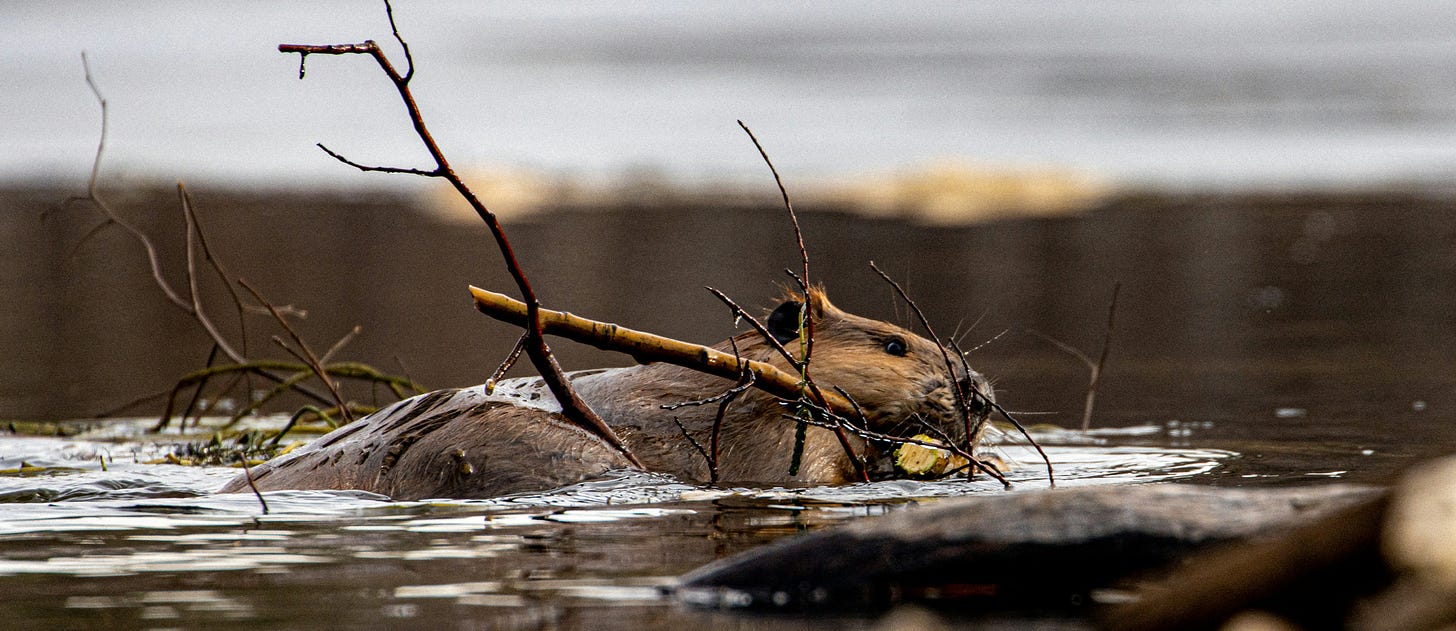Critters taking climate action
Beavers are saving the day, but amphibians can’t take the heat—and how bird watching is a climate action
I have some exciting news: my book, Saving Us, just came out in French this week! A huge thank you to Jean-Francois Mouhot from A Rocha France for leading the effort and Mireille Boissonnat for the wonderful translation.
The French edition is called Défi et espérance pour le climat (Challenge and hope for the climate), and I had the joy of joining the release event virtually last Thursday. If you read French—or know someone who does—you can order your copy here. The book is also available in Dutch and in English, in print, e-book, and audiobook formats.
I love how natural climate solutions can often be better and cheaper than technological ones. Just take what happened in the Czech Republic recently. A new dam on the Klabava River south of Prague to protect critical habitat and endangered crayfish had been on the books since 2018. But the project ground to a halt after hitting bureaucratic delays.
Meanwhile, a colony of beavers took things into their own paws, building a series of dams in the same locations the engineers had planned to. The dams created a wetland that covers almost five acres, saving the Czech government some 1.2 million euros. “It’s full service, beavers are absolutely fantastic and when they are in an area where they can’t cause damage, they do a brilliant job,” said Bohumil Fišer, the head of the Brdy Protected Landscape Area.
“Beavers are brilliant ecosystem engineers and can transform habitats for a huge range of other species,” says Alastair Driver, a rewilding specialist and the former head of conservation for the U.K. Environment Agency. “I spent decades of my career [in the U.K.] rewiggling rivers and installing leaky dams. Beavers do it for free, one thousand times better than people like me ever did.”
Beaver ponds are a haven for wildlife, including fish, amphibians and birds, and their dams help improve water quality as well as providing flood and erosion control. And that's not all; the wetlands built by beaver dams sequester carbon, which helps mitigate climate change.
For more on how beaver dams work, see this fun stop-motion video from Dr. Emily Fairfax from the University of Minnesota.
Frogs and other amphibians can’t take the heat—and as the planet warms, it’s putting these important species at risk.
Amphibians, including frogs and salamanders, are cold blooded. This means they depend on their surroundings to maintain a stable body temperature. On especially hot days, they look for respite in the shade, in water, or even underground. But what does life for them look like on a warmer planet?
Patrice Pottier, an ecology researcher at UNSW Sydney, tried to answer that question in a study published this month. “There is a limit to how much heat amphibians can tolerate,” he writes. This is called the critical thermal maximum.
Two percent of the world’s amphibian species are already too hot, this study found. If temperatures climb 4 degrees Celsius, almost 400 species - or 1 in 13 amphibian species - could reach the limit of their heat tolerance. And since most amphibians aren’t able to migrate away to cooler temperatures, they will simply die off if their environment becomes too hot to accommodate them.
Get outside and go birding! Birding is the original “Pokémon Go”—it teaches us how to begin noticing and appreciating other living things that surround us every day.
In the words of legendary birder Victor Emmanuel, who passed away this week in Austin, Texas, “Birds are very alert; they are aware of any movement. Watching them, we become more alert. We notice everything: the shape of clouds, a change of wind, drops of water that become more like prisms. It gives us a different life.”
Tarik Shahzad is a policy expert who works for The Nature Conservancy, and he’s also a birder. Last year, he went for what birders call his “big year”—the year that you spot the biggest number of bird species in one specific geographic area. Tarik ended up breaking the record for Cook County, where he lives—spotting 294 birds in 2024. His 294th species was the short-tailed shearwater, which as he explains here is a Pacific seabird you would not expect to see in Chicago.
People support climate action because of love—for their kids, future generations, the things and places they cherish. Spending time in nature doing the things we love helps build that connection. And birding is easy—all you need is a pair of binoculars and a website, an app, or a book to help you identify the species you see. So why not give it a try this week?
Tues April 1 at 5:30pm ET - Ignatius Lecture at American University - in person in Washington, DC; livestream information to come
Thurs April 3 at 5pm ET - Faith & Waters Restoration Forum with Oakland Mills Interfaith and Interfaith Partners for the Chesapeake - in person in Columbia, MD, free
Fri April 4 at 7pm ET - Climate change, faith, & culture with Wayne Presbyterian Church - in person in Wayne, Pennsylvania; livestream information to come
Sat April 5 at 10am ET Breakfast and Q&A with Wayne Presbyterian Church - in person in Wayne, Pennsylvania; registration required
Tues April 8 at 11am CT Posey Leadership Award with Austin College - in person in Sherman, TX, free
Weds April 30 at 8pm ET - Don’t Say Climate? Bridging Divides with Katharine Hayhoe a fundraiser for the Climate Psychology Alliance of North America - virtual, $35









Absolutely iconic reminder that birding is the original Pokemon Go! 😂 Gotta "catch" 'em all! (And in the process, as you say, get everyone to fall back in love with our local forest preserves and parks)
Great news in the beavers, many thanks for posting! I’ve got a similar post this week, on beaver rewilding in the uk.